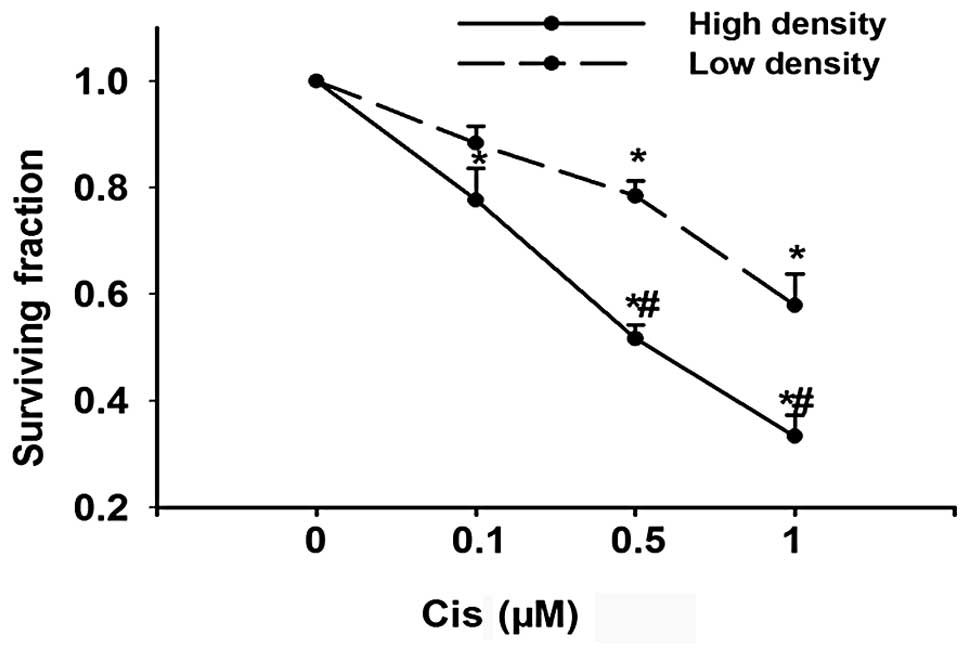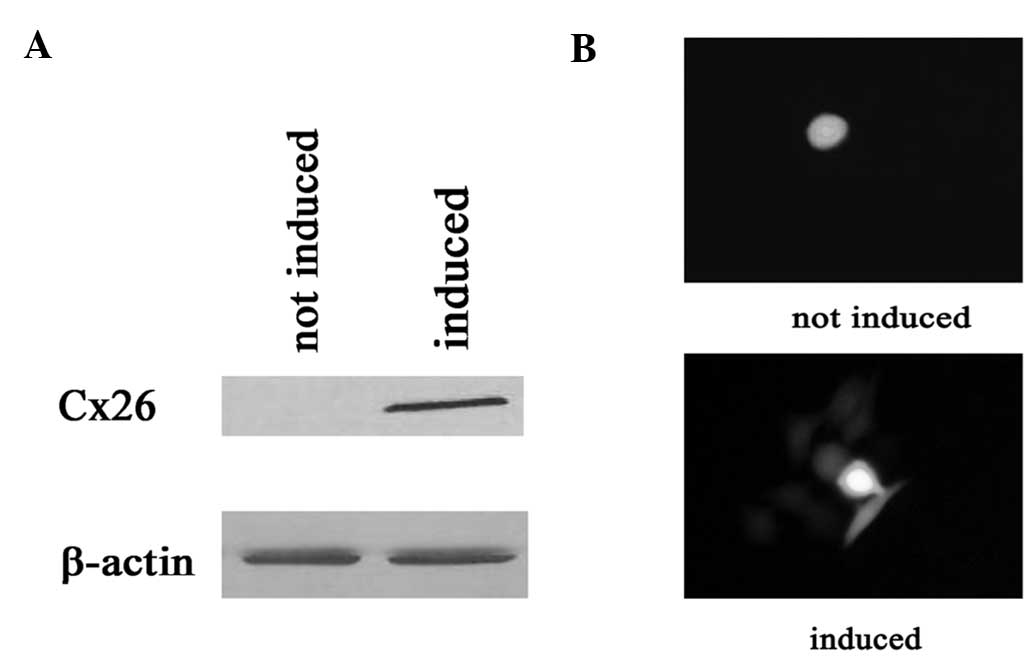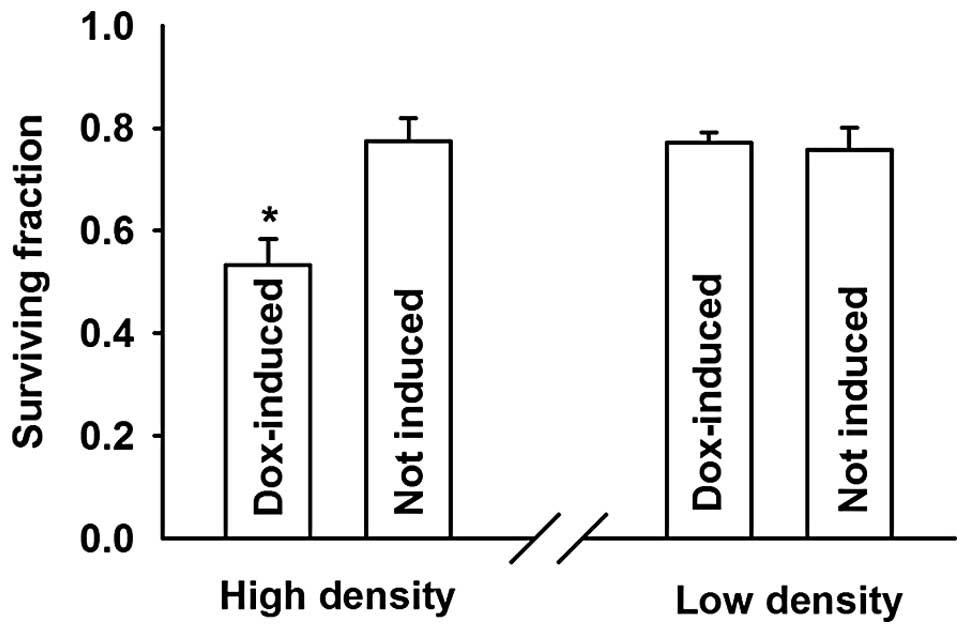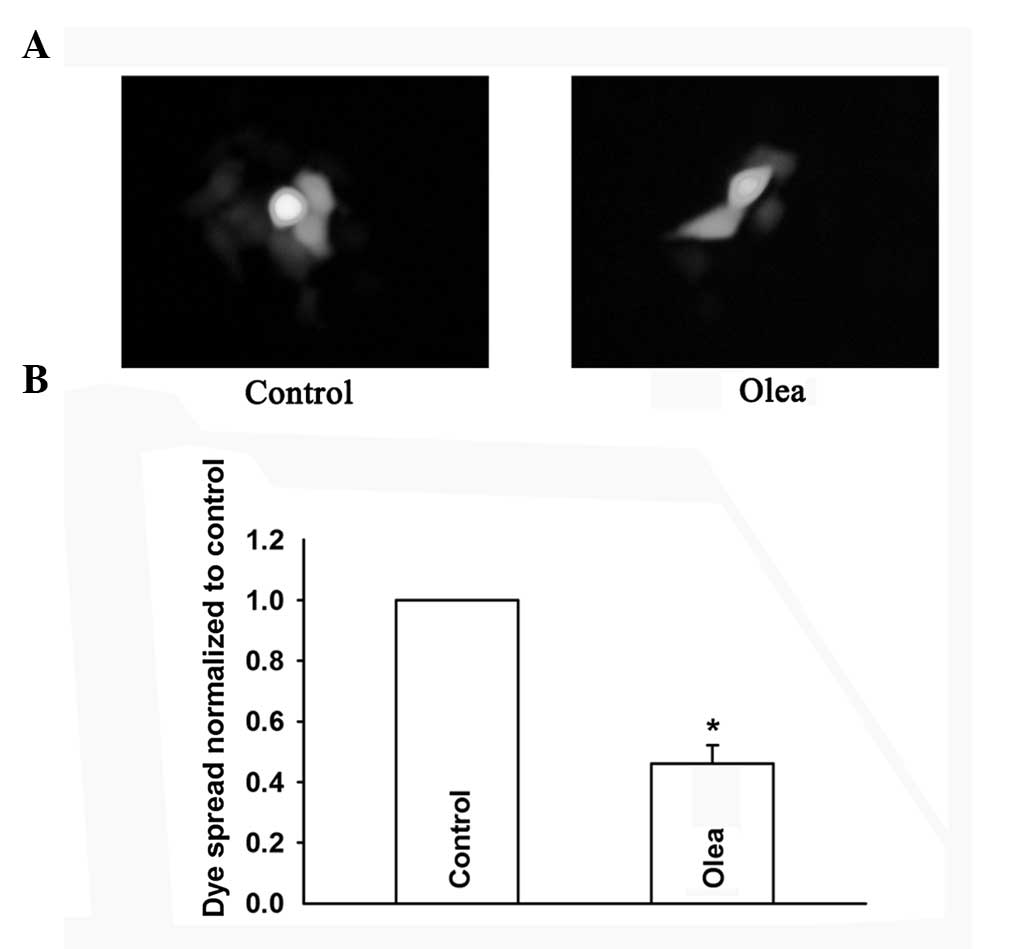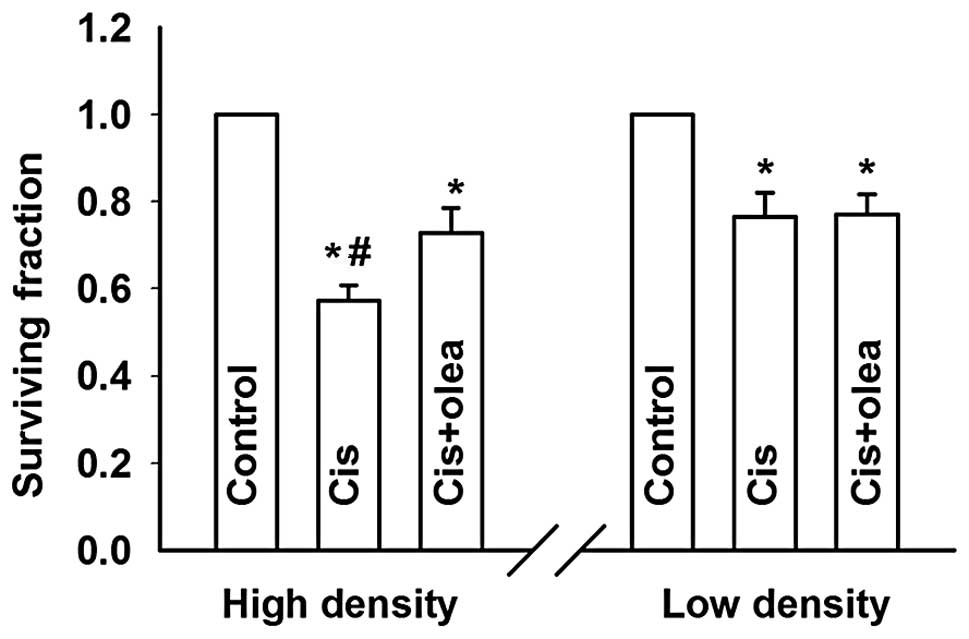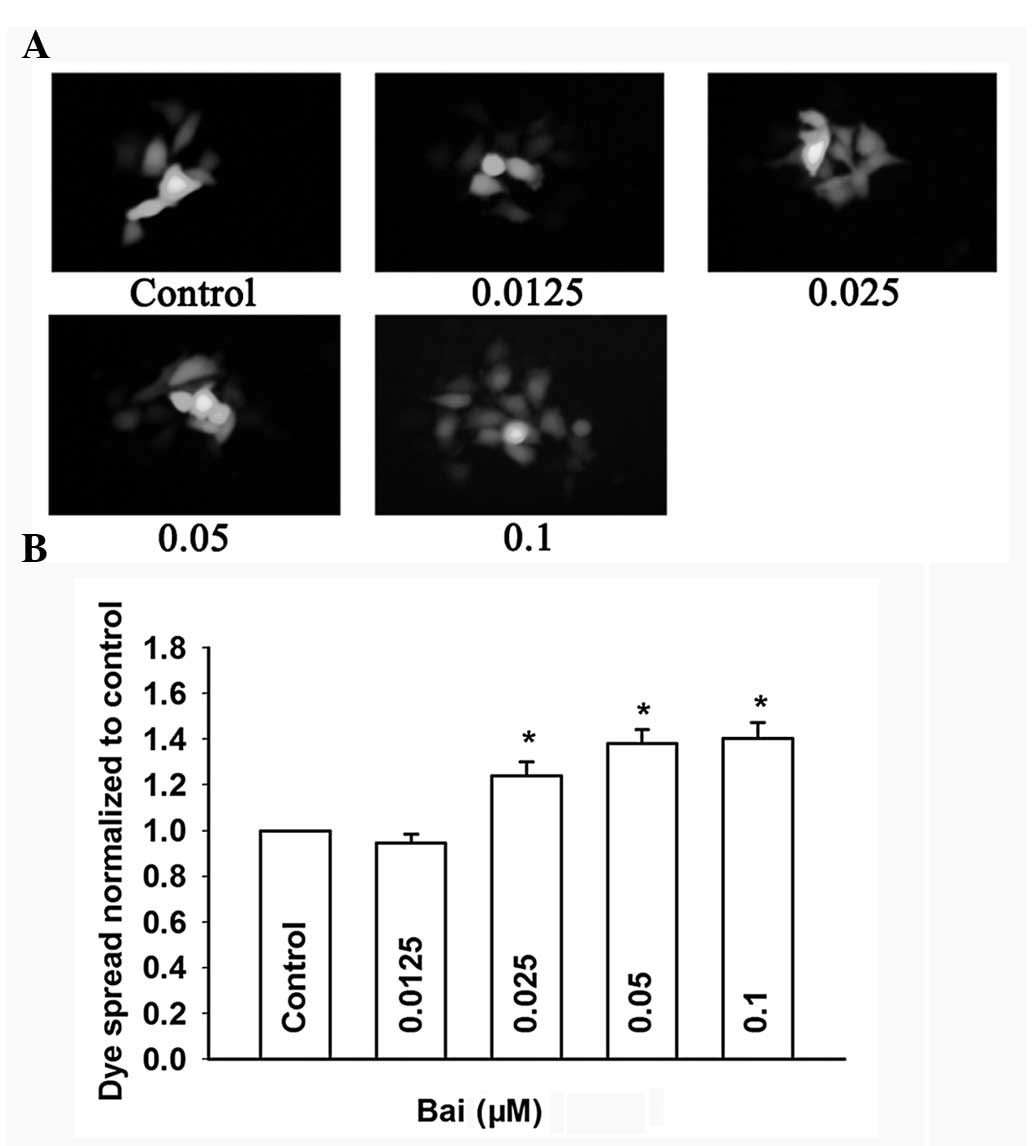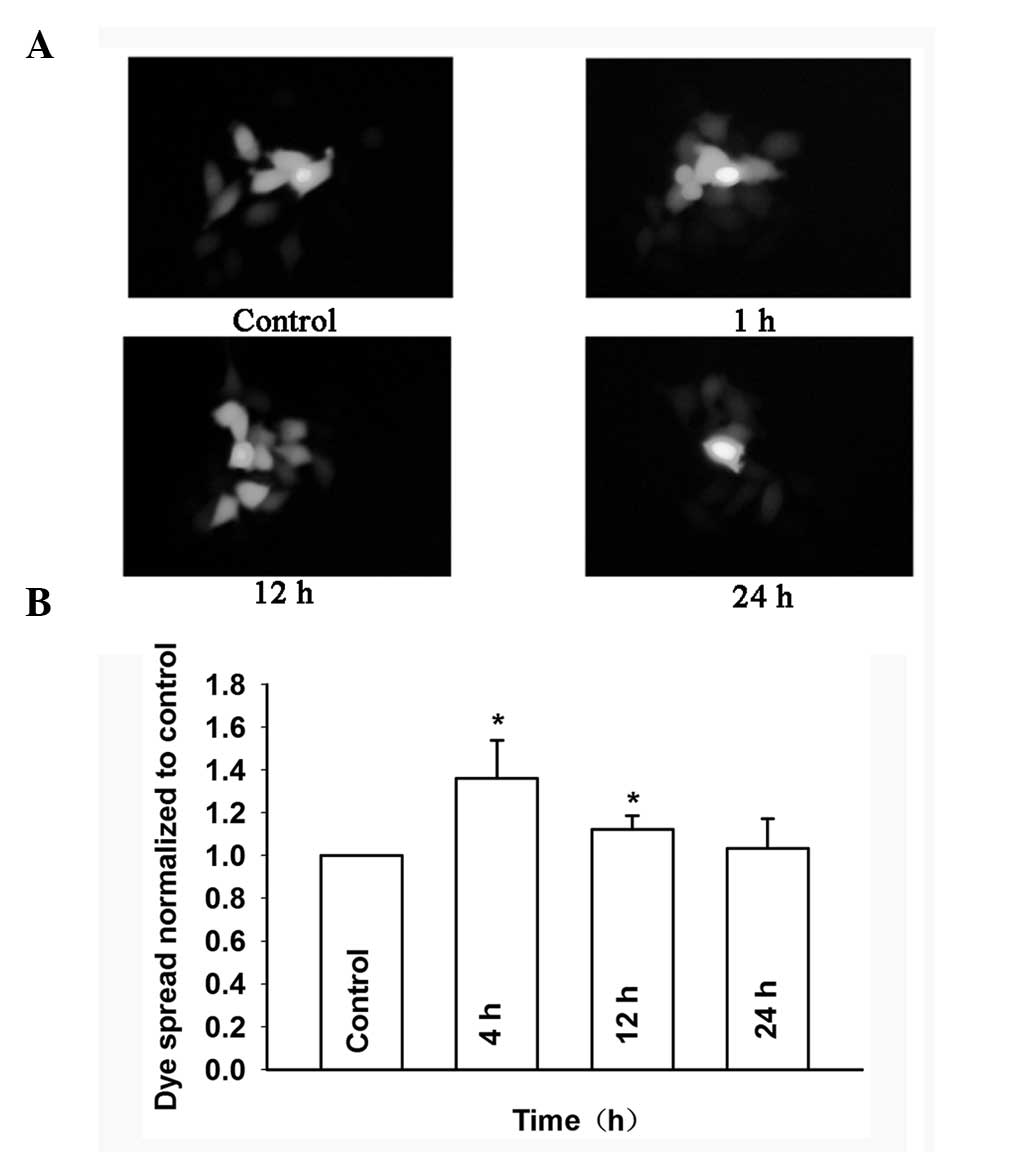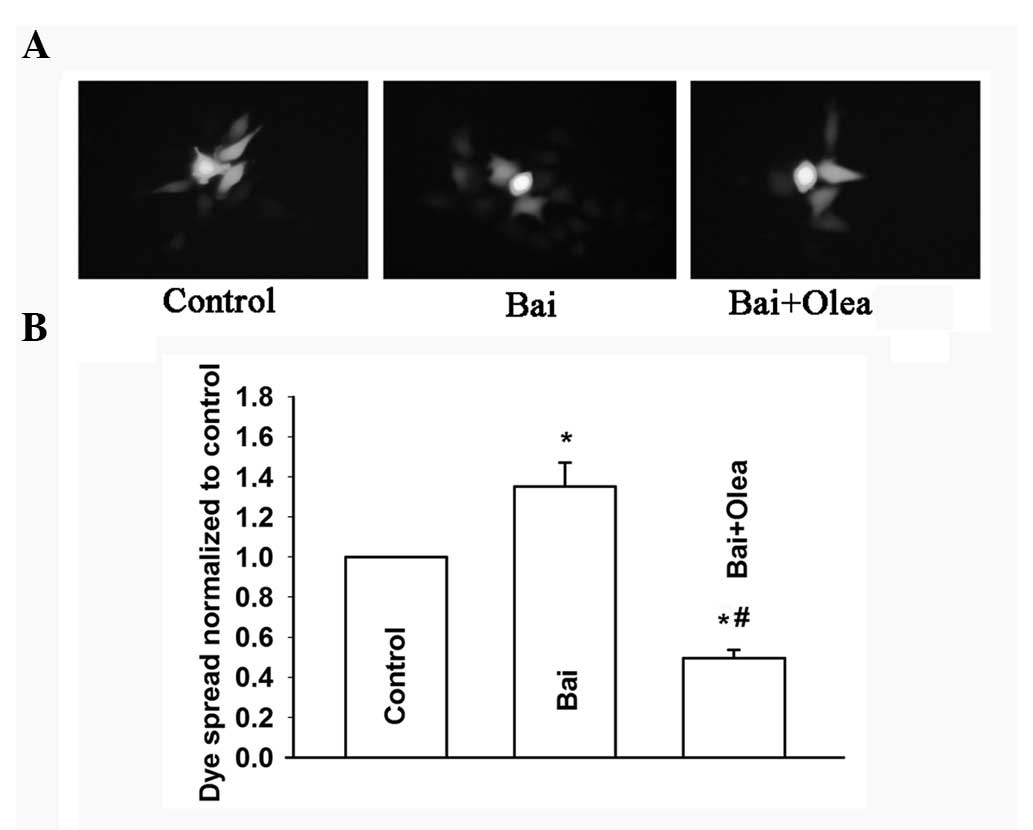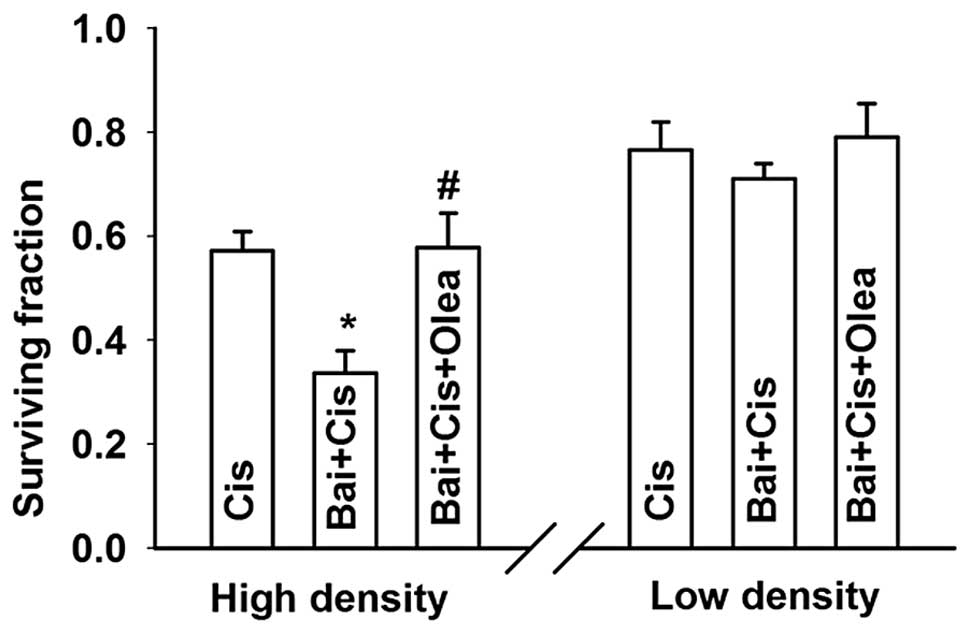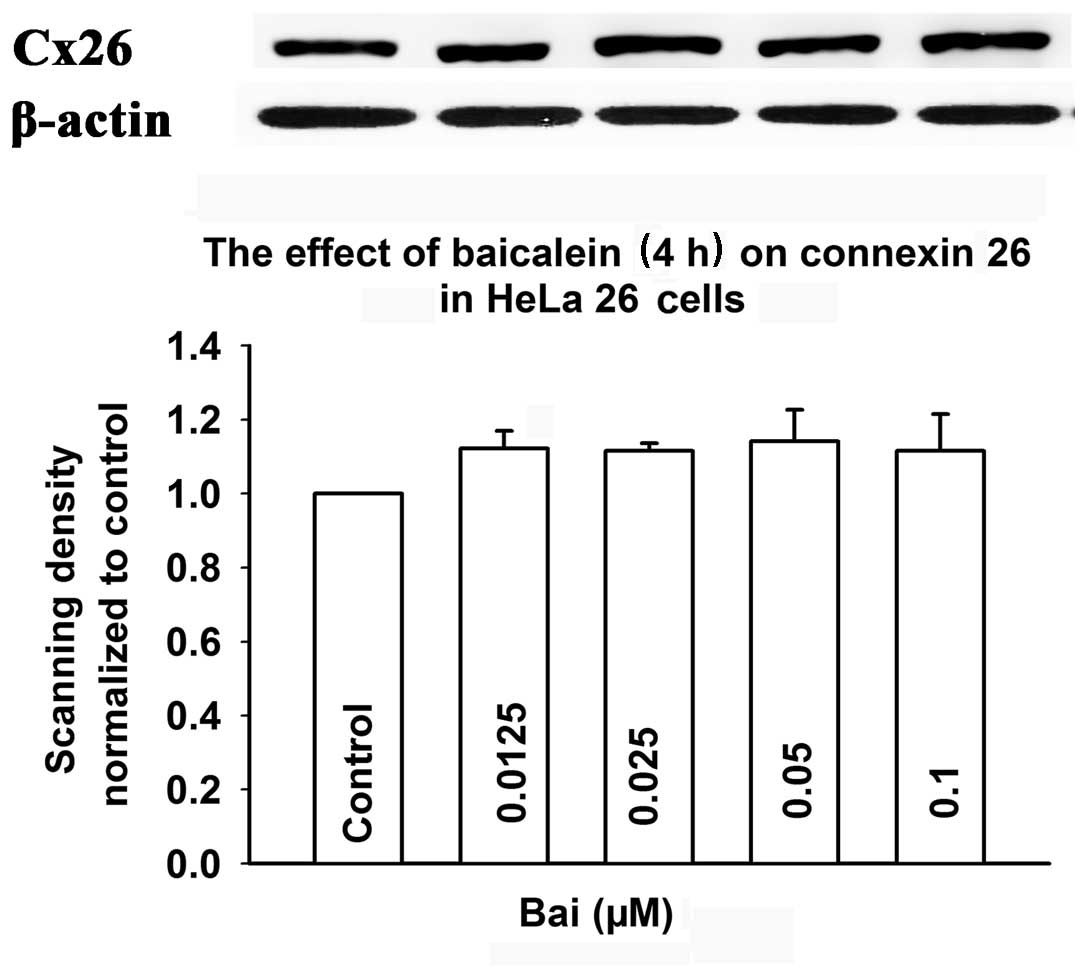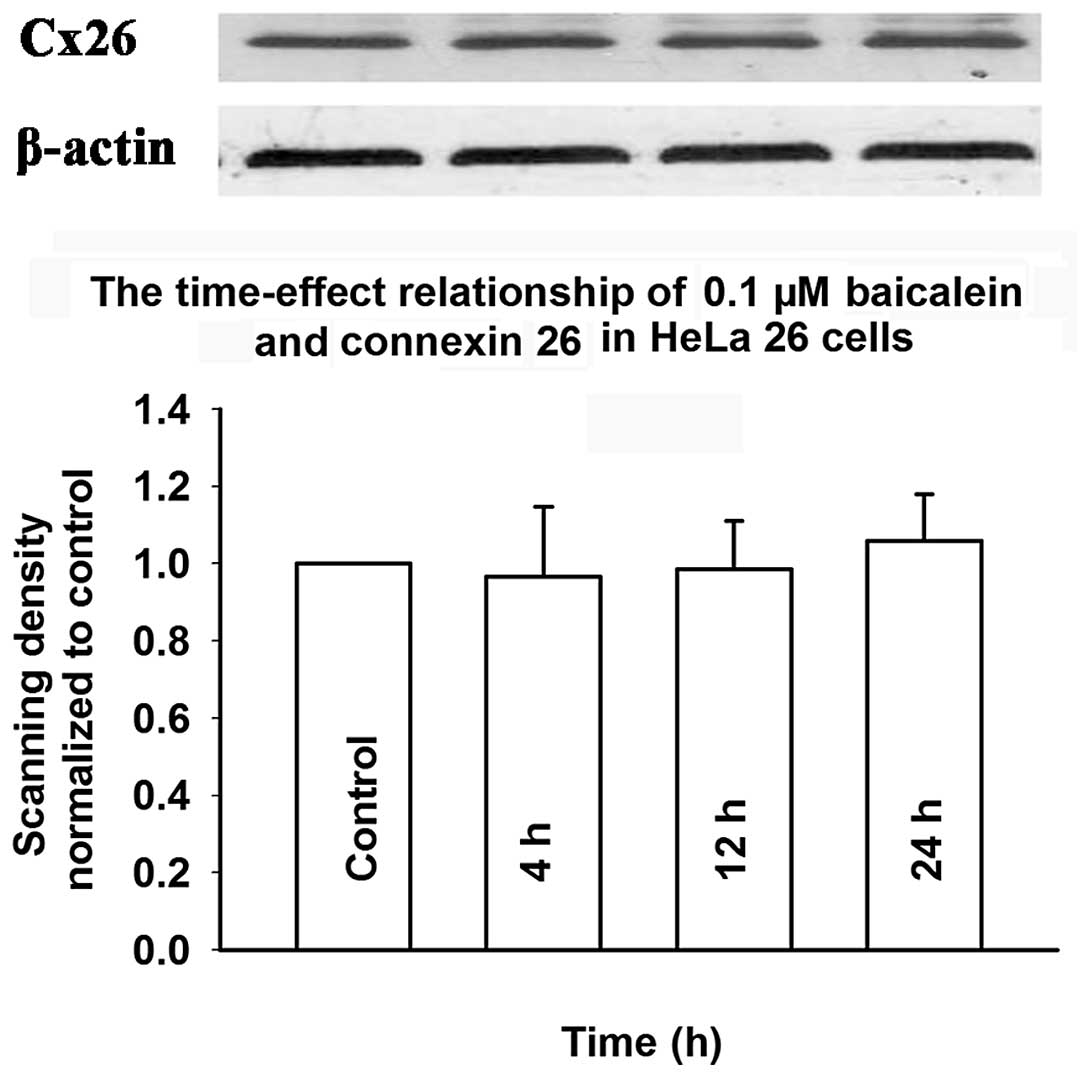Baicalein increases the cytotoxicity of cisplatin by enhancing gap junction intercellular communication
- Authors:
- Published online on: April 16, 2014 https://doi.org/10.3892/mmr.2014.2157
- Pages: 515-521
Abstract
Introduction
Cisplatin is a chemotherapeutic agent. It was approved by the Food and Drug Administration (FDA) in 1978 and has been widely used in the treatment of tumors, such as testicular, ovarian, head and neck, bladder, and small cell lung cancer. Two disadvantages limit its clinical application: severe adverse drug reactions and drug resistance (1,2). Severe adverse drug reactions limit the clinical dose applied to patients, which in turn attenuates its effects. Drug resistance, including natural and acquired drug resistance, leads to failure of the chemotherapeutic treatment. It is thus important to improve the sensitivity of malignant tumors to chemotherapeutic agents, in order to reduce drug dosage and improve the efficacy of treatment.
Gap junction (GJ), a special channel composed of proteins known as connexins (Cx), connects adjacent cells, allowing for direct exchange of small hydrophilic molecules and ions less than 1–2 kDa in size, including metabolites and messengers such as sodium, potassium, calcium, cAMP/cGMP, ADP/ATP, and thereby resulting in the metabolic and electric coupling of cells (3). GJ can promote apoptosis induced by several chemical agents in tumor cells (4,5). Our previous study showed that the enhancement of cisplatin and etoposide cytotoxicity is dependent on the GJ intercellular communication (GJIC) (6). It was hypothesized that GJs may transmit ‘death signals’, i.e., the induced apoptotic or necrotic processes from one cell to neighboring cells, which is known as the ‘bystander effect’. In light of this, intercellular amplification of the death signals by enhancement of GJ formation or function would increase the cytotoxic action of cisplatin, and thus, cisplatin sensitization.
There are a few approaches to increase GJIC in tumor cells, including the use of certain plant-derived flavonoids (7,8). Baicalein is a flavonoid known to display antitumor effects (9–13). However, it remains unknown whether baicalein can improve GJ function and cisplatin cytotoxicity. This study aimed to investigate the effect of baicalein on the cytotoxicity of cisplatin and the relationship between this effect and the modulation of GJ function by baicalein in HeLa cells expressing Cx26. We found that baicalein significantly enhances cell coupling and cisplatin cytotoxicity only in the presence of functional GJs composed of Cx26. These results indicated that baicalein can increase the cytotoxicity of cisplatin through enhancement of GJ function.
Materials and methods
Drugs, antibodies and reagents
Baicalein was purchased from the China National Institutes for Food and Drug Control, (Beijing, China). Cisplatin, anti-haemagglutinin (HA) mouse IgG, sulforhodamine B, trichloroacetic acid, acetic acid, Tris, dimethylsulfoxide (DMSO) and oleamide were purchased from Sigma-Aldrich (St. Louis, MO, USA). Cell culture reagents were purchased from Gibco-BRL (Grand Island, NY, USA) and calcein acetoxymethyl ester (AM) was purchased from Invitrogen Life Technologies (Calrsbad, CA, USA). G418, hygromycin, and doxycycline were purchased from Calbiochem (San Diego, CA, USA). Secondary antibodies for western blotting were purchased from Amersham Biosciences (Piscataway, NJ, USA). All other reagents were purchased from Sigma-Aldrich unless otherwise stated.
Cell lines and culture
The HeLa cell line expressing Cx26 was previously described and characterized (14). In this cell line, obtained via transfection, Cx26 expression is under the control of a single bidirectional tetracycline-inducible promoter. Cx26 has a thrombin-cleavable C-terminal epitope tag (3.2 kDa) that includes an HA epitope. Cx26-expressing HeLa cells were cultured in Dulbecco’s modified Eagle’s medium (DMEM), 10% newborn bovine serum, 100 μg/ml G418 sulfate, and 200 μg/ml hygromycin B at 37°C in a 5% CO2 humidified incubator. Connexin expression was induced by incubation with 1 μg/ml doxycycline for 48 h prior to all experiments.
Sulforhodamine B (SRB) assay
The SRB colorimetric assay was used to measure the toxic effect of baicalein on cell viability (15). Cells were seeded onto 96-well plates for 24 h, followed by incubation with different concentrations of baicalein for 24 h, and were cultured for an additional 12 h. The culture medium was then removed and the cells were fixed with 50 μl of ice-cold 50% trichloroacetic acid solution at 4°C for 60 min, rinsed five times with tap water and dried at room temperature overnight. Next, 100 μl of 0.4% SRB solution was added to each well and incubated at room temperature for 30 min. Unbound dye was removed by washing five times with 1% acetic acid solution and drying at room temperature. A total of 10 mM Tris base solution (pH 10.5) was used to dissolve the protein-bound dye, and the plate was placed on a plate shaker for 15 min. The optical density (OD)570 nm was measured using a 96-well MRX plate reader (Dynex Technologies, Chantilly, VA, USA).
Gap junction dye-coupling (parachute) assay
Functional GJs were examined as described by Goldberg et al (16). Cells were grown to confluence in 12-well plates. Donor cells from one well were incubated with growth medium supplemented with a freshly made solution of 5 μmol/l calcein AM for 30 min at 37°C. Calcein AM is intracellularly converted into the GJ-permeable dye calcein. After three consecutive washes with phosphate-buffered saline (PBS) to remove excess dye, the donor cells were trypsinized and seeded onto the receiver cells at a 1:150 donor/receiver ratio. They were allowed to form GJs for 4 h at 37°C and then examined under a fluorescence microscope (IX71; Olympus, Tokyo, Japan). Images were captured of ~20 cells per well (magnification, ×400) to count receiver cells containing calcein per donor cell. The average number of receiver cells containing calcein per donor cell was used as a measure of the GJIC.
Western blotting
Following three washes with ice-cold PBS, cells were lysed using lysis buffer (20 mM Tris-HCl pH 7.4, 150 mM NaCl, 1 mM EDTA, 1 mM EGTA, 1% Triton, 2.5 mM sodium pyrophosphate, 1 mM Na3VO4, 1 mM β-glycerophosphate, 1:1,000 protease inhibitors). The cell lysate was sonicated and centrifuged at 14,167 × g for 30 min at 4°C. The DC protein assay kit was used to determine the protein concentration (Bio-Rad, Hercules, CA, USA). A total of 20 μg of protein from each sample was analyzed by sodium dodecyl sulfate (SDS)-polyacrylamide gel electrophoresis (PAGE) and transferred to nitrocellulose blotting membranes, followed by immunoblotting. Monoclonal antibodies against HA IgG (1:1,000) or β-actin (1:10,000) were used. Immunopositive bands were visualized using the Amersham ECL™ Plus Western Blotting Detection kit (GE Healthcare).
Colony-forming assay
All experiments of cell exposure to cisplatin were performed in the dark at 37°C. Baicalein was dissolved in DMSO. When combined treatment with cisplatin and baicalein was performed, baicalein was added to the cells 3 h prior to cisplatin addition. The GJ inhibitor oleamide was added to the cell culture medium at a 50 μM concentration 3 h prior to the exposure to cisplatin.
Cisplatin toxicity was assessed by a standard colony forming assay as described by Jenser et al (5) with a few modifications. Briefly, cells were cultured at low (100 cells/cm2) or high density (30,000 cells/cm2), corresponding to conditions permissive of gap junction formation or not, respectively. For the high-density condition, cells were grown to confluence prior to cisplatin exposure. Following treatment with cisplatin for 1 h, cells were washed with PBS, harvested by trypsinization, counted, and seeded onto 6-well dishes at a 500 cells/well density. The cells were incubated for an additional 7-day period, and next fixed and stained with 1% crystal violet in ethanol. Colonies containing ≥50 cells were counted. Colony formation rates were normalized to the efficiency of colony formation of cells not treated with drugs (control). For the low-density condition, cells were seeded onto 6-well plates at a 100 cells/ml density. After 4 h adherence, cells were exposed to cisplatin and then replenished with fresh medium. They were rinsed and assessed for colony formation as described above. Cells in this condition were unable to form GJs, since there is no possibility to contact each other at such low density.
To avoid discrepancy in results caused by the fact that cells are at different cell cycle phases, we incubated the cells in serum-free medium for 24 h prior to the addition of cisplatin, to ensure cell synchronicity at the G1 phase.
Statistical analysis
Data from the experiments of different treatments were analyzed by unpaired Student’s t-tests using the SigmaPlot 10.0 software (Systat Software Inc., San Jose, CA, USA). Data are presented as mean ± SEM. P<0.05 was considered to indicate statistically significant differences.
Results
Cisplatin cytotoxicity is cell density-dependent
GJ channels are formed by the end-to-end docking of two hemichannels in adjacent cells; GJIC occurs only when cells contact each other. As an initial experiment to determine the effect of GJIC on cisplatin toxicity, Cx26-expressing HeLa cells were cultured under conditions where GJ formation was possible (high density; 30,000 cells/cm2) or not (low density; 100 cells/cm2). In both conditions, cisplatin caused cell death in a concentration-dependent manner. However, the toxic effect of cisplatin was substantially greater at high-density compared to low-density cultures (Fig. 1). This indicates that cell culture density might have an effect on cisplatin cytotoxicity. The concentration of cisplatin used in the experiment was within the therapeutic range used during chemotherapy (17).
Effects of cell density are due to GJIC
The formation of GJs is only one of the numerous differences between cells cultured at low and high density. To determine whether the effects of high cell density were due to GJIC, GJ coupling was examined in the cultures under different conditions of connexin expression and chemical inhibition.
First, connexin expression was studied in Cx26-expressing HeLa cells. Connexin expression was induced by incubation with 1 μg/ml doxycycline for 48 h (see Materials and methods). Fig. 2A and B show the expression of connexin and GJ dye coupling 48 h following exposure to doxycycline.
The cells treated with doxycycline (expressing connexin, GJs formed) showed a markedly higher sensitivity to cisplatin at high compared to low density growth conditions. The surviving fraction decreased from 0.78±0.04 to 0.53±0.05, respectively. Notably, the inhibition of cell survival by cisplatin was not affected by addition of doxycycline in low density cultures (Fig. 3).
To further assess the role of GJIC on cell density-dependent cisplatin sensitivity, oleamide, a GJ channel inhibitor (18), was used to inhibit GJIC in HeLa cells, and its effect was assessed by the GJ dye-coupling assay (Fig. 4A and B). In low-density cultures (without GJIC), treatment with oleamide did not affect cisplatin toxicity. However, in high-density cultures (with GJIC), cisplatin toxicity was attenuated upon inhibition of GJIC by oleamide, manifested as a significant increase of the cell surviving fraction from 0.57±0.04 to 0.73±0.06 (Fig. 5). Thus, inhibition of GJIC during the 1 h of exposure to cisplatin reversed the effect of high density cell culture on cisplatin toxicity.
These results indicated that GJIC enhances cisplatin toxicity and fully accounts for the observed density-dependent effect of cisplatin toxicity.
Effects of baicalein on cell viability
The formation of GJs composed of Cx26 affected the cytotoxicity of cisplatin. This observation was consistent with our hypothesis that enhancement of the GJ function would increase the cytotoxic action of cisplatin, and thus increase cisplatin sensitization. Would baicalein affect the GJ function and cisplatin cytotoxicity? To determine this, we first examined the cytotoxic effect of baicalein using the SRB assay.
As shown in Fig. 6, baicalein had no effect on cell viability until the concentration reached 100 μM. Thus, the concentrations of baicalein used in the following experiments (≤0.1 μM) had no cytotoxic effect on HeLa cells.
Effects of baicalein on GJ function
The effect of baicalein on dye coupling among cultured cells was assayed by the parachute assay. Donor cells were labeled with the junction-permeable dye calcein and then seeded onto unlabeled receiver cells with different concentrations of baicalein for 4 h. GJ intercellular communication was expressed as the number of receiver cells receiving calcein from a labeled cell, normalized to that of control cells (non-treated). As shown in Fig. 7A and B, baicalein markedly increased the dye spread from donor cells to receiver cells in a dose-dependent manner. Fig. 8A and B show that the dye spread through GJs treated with 0.1 μM baicalein was markedly decreased from 4 to 24 h in Cx26-transfected HeLa cells. These results indicated that baicalein can enhance GJIC in Cx26-expressing HeLa cells.
Effects of baicalein on cisplatin cytotoxicity and GJ
The effects of baicalein on cisplatin-induced cytotoxicity were examined in HeLa cells expressing Cx26. Cells seeded at high or low cell density were treated with baicalein (0.1 μM) for 3 h, followed by exposure to 0.5 μM cisplatin + baicalein for 1 h. The clonogenic survival of HeLa cells was assessed 7 days following exposure to cisplatin and baicalein. Baicalein enhanced cisplatin cytotoxicity in high-density cultures but had no effect in low-density cultures; the surviving fraction substantially decreased from 0.57±0.04 in low-density cultures to 0.34±0.04 in high-density cultures. This effect of baicalein was only observed in conditions permissive of GJ formation.
To further assess the role of GJIC in the improvement of cisplatin sensitivity induced by baicalein, oleamide was used to inhibit GJIC in HeLa cells (Fig. 9A and B). Consistent with our previous results, treatment with oleamide and baicalein did not affect cisplatin toxicity in low-density cell cultures (without GJIC). However, the improvement of cisplatin toxicity induced by baicalein was attenuated upon inhibition of GJIC by oleamide in high-density cultures (with GJIC). An increase of the surviving fraction, from 0.34±0.04 to 0.58±0.07, was observed (Fig. 10). These results showed that oleamide can inhibit the improvement of the dye spread through GJs induced by baicalein, and thus reduce cisplatin cytotoxicity improved by baicalein at high cell density. Therefore, baicalein improves cisplatin cytotoxicity by enhancing GJIC in Cx26-expressing HeLa cells.
Effects of baicalein on connexin expression
To determine whether baicalein affects the expression of connexin, the level of Cx26 was assessed by western blotting in cells induced by doxycycline and exposed to baicalein. Fig. 11 shows that treatment with baicalein (0.0125–0.1 μM) for 4 h did not affect Cx26 expression. Fig. 12 shows that treatment with baicalein (0.1 μM) for 4 to 24 h did not change Cx26 expression. These results suggested that the mechanism of baicalein-induced enhancement of GJIC does not involve an increase in the expression of connexin.
Discussion
Cx26 is widely and highly expressed in numerous tissues such as liver, mammary gland, skin and appendages, mucous membranes, pancreas, intestine, endometrium, lung and brain (19). GJs composed by Cx26 play an important role in the ‘bystander effect’. HeLa cells transfected with the herpes simplex virus thymidine kinase gene (HSV-tk) were more susceptible to death when expressing Cx26 and forming GJs. The bystander effect disappeared when GJIC was inhibited (20). This phenomenon was also observed in a bladder cancer cell line transfected with HSV-tk. Cx26 expression and the induction of functional GJs facilitated HSV-tk/ganciclovir (GCV) gene therapy through the bystander effect (21). Gemcitabine administration in mice bearing tumors that overexpress Cx26 resulted in marked regression of the tumor (22). These findings have prompted us to study the effect of Cx26 channels on cisplatin cytotoxicity.
Consistent with previous reports (4–6), the results of the present study showed that cisplatin toxicity is GJ-dependent. Cisplatin toxicity was enhanced in high-density cultures where GJIC occurred, but not in low-density cultures, which lacked junction contacts. Moreover, cisplatin cytotoxicity was attenuated upon inhibition of GJIC by oleamide. Our results thus demonstrated that GJs composed of Cx26 play an important role in cisplatin cytotoxicity. We further argue that cisplatin cytotoxicity can be increased by enhancing GJIC.
The antitumor effects of baicalein have been extensively studied (9–13). Few studies however investigated the effect of baicalein on GJ function and cisplatin-induced cytotoxicity. Our results showed that treatment with baicalein (0.0125–0.1 μM) for 4 h increased the cell coupling mediated by the Cx26 channels. Importantly, we found that in high-density cultures, where there was substantial intercellular contact, baicalein enhanced the function of GJ and the cytotoxicity of cisplatin, with the cell surviving fraction decreasing from 0.57±0.04 to 0.34±0.04. This decrease was not observed in low-density cultures, which lacked intercellular contacts. The results of the experiments with the GJ inhibitor oleamide further supported the link between GJIC and the enhancement of cisplatin cytotoxicity. In high-density cultures, inhibition of GJIC via oleamide attenuated the improvement of cisplatin cytotoxicity induced by baicalein, with the surviving fraction significantly increasing from 0.34±0.04 to 0.58±0.07. By contrast, in low-density cultures, oleamide did not significantly alter the effects of baicalein. Our study provided the first evidence that the enhancement of cisplatin cytotoxicity by baicalein may be achieved through the enhancement of the GJ function in HeLa cells.
It is very common in clinical tumor therapy to combine chemotherapeutic agents to obtain additive or synergistic effects. Cisplatin is one of the most widely used cancer chemotherapeutic agents. Baicalein was also shown in recent studies to exert beneficial effects in clinic tumor therapy (9–11). While the underlying mechanism was not clarified, it was hypothesized that baicalein inhibits multi-drug resistance gene expression and decreases the level of the permeability glycoprotein (P-gp), thus increasing the intracellular concentration of chemotherapeutic agents (23). Our study found that the Cx26 channel may also mediate the improvement of cisplatin cytotoxicity induced by baicalein. We also found that in the presence of GJ, baicalein (0.1 μM) is not toxic to HeLa cells, but increases the cytotoxicity of cisplatin by ~23%, suggesting that when baicalein is combined with cisplatin, the dosage of the latter can be reduced without compromising the efficiency of its tumoricidal effect.
As for the mechanism of enhancement of GJIC induced by baicalein, our results showed that baicalein did not affect the expression of Cx26 at any tested concentration (0.0125–0.1 μM) or duration of treatment (4–24 h). Therefore, baicalein improved GJIC without changing the expression of Cx26. There are numerous factors modulating the activity of GJ channels. Cx26 is a connexin, and connexins have long been reported to be regulated by phosphorylation at serine and threonine residues (24,25). However, Cx26 is not a phosphoprotein (26,27). It is thus unlikely that baicalein can modulate the activity of Cx26-composed GJs by phosphorylation. A number of studies showed that flavonoids mostly influence GJ function by changing the expression of connexin and its phosphorylation status (7,8,28,29). It was reported that two flavonoids, apigenin and tangeretin, can counteract tumor promoter-induced inhibition of intercellular communication of rat liver epithelial cells without changing connexin 43 and in its phosphorylation state (7). Our results are similar to results of this study, but the mechanism by which baicalein enhances GJ function in HeLa cells was not elucidated. Nevertheless, our results demonstrated that baicalein enhances GJ function without changing connexin expression. Moreover, the present results also suggest that baicalein may be developed as a non-toxic chemo-adjuvant and could be used to increase the efficacy of existing anticancer chemotherapies by enhancing the GJ functionality.
Acknowledgements
This study was supported by grants from the Department of Science and Technology of Xinjiang Uygur Autonomous Regions (no. 201233150) and the National Natural Science Foundation of China (nos. 30973434 and 30901807).
References
|
Giaccone G: Clinical perspectives on platinum resistance. Drugs. 59(Suppl 4): 9–17. 2000. View Article : Google Scholar | |
|
Fuertes MA, Alonso C and Pérez JM: Biochemical modulation of cisplatin mechanisms of action: enhancement of antitumor activity and circumvention of drug resistance. Chem Rev. 103:645–662. 2003. View Article : Google Scholar : PubMed/NCBI | |
|
King TJ and Bertram JS: Connexins as targets for cancer chemoprevention and chemotherapy. Biochim Biophys Acta. 1719:146–160. 2005. View Article : Google Scholar : PubMed/NCBI | |
|
Kalvelyte A, Imbrasaite A, Bukauskiene A, Verselis VK and Bukauskas FF: Connexins and apoptotic transformation. Biochem Pharmacol. 66:1661–1672. 2003. View Article : Google Scholar : PubMed/NCBI | |
|
Jensen R and Glazer PM: Cell-interdependent cisplatin killing by Ku/DNA-dependent protein kinase signaling transduced through gap junctions. Proc Natl Acad Sci USA. 101:6134–6139. 2004. View Article : Google Scholar : PubMed/NCBI | |
|
Wang Q, You T, Yuan D, Han X, Hong X, He B, Wang L, Tong X, Tao L and Harris AL: Cisplatin and oxaliplatin inhibit gap junctional communication by direct action and by reduction of connexin expression, thereby counteracting cytotoxic efficacy. J Pharmacol Exp Ther. 333:903–911. 2010. View Article : Google Scholar | |
|
Chaumontet C, Bex V, Gaillard-Sanchez I, Seillan-Heberden C, Suschetet M and Martel P: Apigenin and tangeretin enhance gap junctional intercellular communication in rat liver epithelial cells. Carcinogenesis. 15:2325–2330. 1994. View Article : Google Scholar : PubMed/NCBI | |
|
Conklin CM, Bechberger JF, MacFabe D, Guthrie N, Kurowska EM and Naus CC: Genistein and quercetin increase connexin43 and suppress growth of breast cancer cells. Carcinogenesis. 28:93–100. 2007. View Article : Google Scholar : PubMed/NCBI | |
|
Wang L, Ling Y, Chen Y, Li CL, Feng F, You QD, Lu N and Guo QL: Flavonoid baicalein suppresses adhesion, migration and invasion of MDA-MB-231 human breast cancer cells. Cancer Lett. 297:42–48. 2010. View Article : Google Scholar : PubMed/NCBI | |
|
Cheng YH, Li LA, Lin P, Cheng LC, Hung CH, Chang NW and Lin C: Baicalein induces G1 arrest in oral cancer cells by enhancing the degradation of cyclin D1 and activating AhR to decrease Rb phosphorylation. Toxicol Appl Pharmacol. 263:360–367. 2012. View Article : Google Scholar : PubMed/NCBI | |
|
Takahashi H, Chen MC, Pham H, Angst E, King JC, Park J, Brovman EY, Ishiguro H, Harris DM, Reber HA, Hines OJ, Gukovskaya AS, Go VL and Eibl G: Baicalein, a component of Scutellaria baicalensis, induces apoptosis by Mcl-1 down-regulation in human pancreatic cancer cells. Biochim Biophys Acta. 1813:1465–1474. 2011. | |
|
Chen CH, Huang TS, Wong CH, Hong CL, Tsai YH, Liang CC, Lu FJ and Chang WH: Synergistic anti-cancer effect of baicalein and silymarin on human hepatoma HepG2 cells. Food Chem Toxicol. 47:638–644. 2009. View Article : Google Scholar : PubMed/NCBI | |
|
Zhang Y, Song L, Cai L, Wei R, Hu H and Jin W: Effects of baicalein on apoptosis, cell cycle arrest, migration and invasion of osteosarcoma cells. Food Chem Toxicol. 53:325–333. 2013. View Article : Google Scholar : PubMed/NCBI | |
|
Koreen IV, Elsayed WA, Liu YJ and Harris AL: Tetracycline-regulated expression enables purification and functional analysis of recombinant connexin channels from mammalian cells. Biochem J. 383:111–119. 2004. View Article : Google Scholar | |
|
Papazisis KT, Geromichalos GD, Dimitriadis KA and Kortsaris AH: Optimization of the sulforhodamine B colorimetric assay. J Immunol Methods. 208:151–158. 1997. View Article : Google Scholar : PubMed/NCBI | |
|
Goldberg GS, Bechberger JF and Naus CC: A pre-loading method of evaluating gap junctional communication by fluorescent dye transfer. Biotechniques. 18:490–497. 1995.PubMed/NCBI | |
|
Erdlenbruch B, Nier M, Kern W, Hiddemann W, Pekrun A and Lakomek M: Pharmacokinetics of cisplatin and relation to nephrotoxicity in paediatric patients. Eur J Clin Pharmacol. 57:393–402. 2001. View Article : Google Scholar : PubMed/NCBI | |
|
Guan X, Cravatt BF, Ehring GR, Hall JE, Boger DL, Lerner RA and Gilula NB: The sleep-inducing lipid oleamide deconvolutes gap junction communication and calcium wave transmission in glial cells. J Cell Biol. 139:1785–1792. 1997. View Article : Google Scholar : PubMed/NCBI | |
|
Krysko DV, Leybaert L, Vandenabeele P and D’Herde K: Gap junctions and the propagation of cell survival and cell death signals. Apoptosis. 10:459–469. 2005. View Article : Google Scholar : PubMed/NCBI | |
|
Mesnil M, Piccoli C and Yamasaki H: A tumor suppressor gene, Cx26, also mediates the bystander effect in HeLa cells. Cancer Res. 57:2929–2932. 1997.PubMed/NCBI | |
|
Tanaka M, Fraizer GC, De La Cerda J, Cristiano RJ, Liebert M and Grossman HB: Connexin 26 enhances the bystander effect in HSVtk/GCV gene therapy for human bladder cancer by adenovirus/PLL/DNA gene delivery. Gene Ther. 8:139–148. 2001. View Article : Google Scholar : PubMed/NCBI | |
|
Garcia-Rodríguez L, Pérez-Torras S, Carrió M, Cascante A, García-Ribas I, Mazo A and Fillat C: Connexin-26 is a key factor mediating gemcitabine bystander effect. Mol Cancer Ther. 10:505–517. 2011.PubMed/NCBI | |
|
Li DR, Zhang W, Tang DP, Tu WS and Qin J: A study of the reverse effect of scutellarein on multidrug-resistant human ovarian carcinoma cell line A2780/ADM. Tumor. 24:111–113. 2004. | |
|
Lampe PD and Lau AF: The effects of connexin phosphorylation on gap junctional communication. Int J Biochem Cell Biol. 36:1171–1186. 2004. View Article : Google Scholar : PubMed/NCBI | |
|
Warn-Cramer BJ and Lau AF: Regulation of gap junctions by tyrosine protein kinases. Biochim Biophys Acta. 1662:81–95. 2004. View Article : Google Scholar : PubMed/NCBI | |
|
Traub O, Look J, Dermietzel R, Brümmer F, Hülser D and Willecke K: Comparative characterization of the 21-kD and 26-kD gap junction proteins in murine liver and cultured hepatocytes. J Cell Biol. 108:1039–1051. 1989. View Article : Google Scholar : PubMed/NCBI | |
|
Sáez JC, Nairn AC, Czernik AJ, Spray DC, Hertzberg EL, Greengard P and Bennett MV: Phosphorylation of connexin 32, a hepatocyte gap-junction protein, by cAMP-dependent protein kinase, protein kinase C and Ca2+/calmodulin-dependent protein kinase II. Eur J Biochem. 192:263–273. 1990.PubMed/NCBI | |
|
Chaumontet C, Droumaguet C, Bex V, Heberden C, Gaillard-Sanchez I and Martel P: Flavonoids (apigenin, tangeretin) counteract tumor promoter-induced inhibition of intercellular communication of rat liver epithelial cells. Cancer Lett. 114:207–210. 1997. View Article : Google Scholar | |
|
Huard C, Druesne N, Guyonnet D, Thomas M, Pagniez A, Le Bon AM, Martel P and Chaumontet C: Diallyl disulfide (DADS) enhances gap-junctional intercellular communication by both direct and indirect mechanisms in rat liver cells. Carcinogenesis. 25:91–98. 2004. View Article : Google Scholar : PubMed/NCBI |



